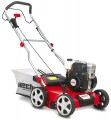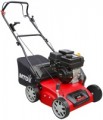Working width
The width of the strip processed by the aerator in one pass. The higher this indicator, the faster the device works, the fewer passes will have to be made to process a certain area. On the other hand,
a wide grip noticeably affects the dimensions of the entire structure and makes it difficult to work in hard-to-reach places, if not impossible. Therefore, when choosing a model in terms of working width, it is worth considering not only the overall dimensions of the site, but also its configuration and the presence of tight areas — sometimes it is preferable to sacrifice the performance of the aerator for the sake of its manoeuvrability and patency.
Max. processing height
The highest processing height provided by the aerator.
This parameter describes the maximum height above the lawn surface that the working head can be raised to. It is of practical importance only for models with scarifier functions (see "Type"): it is this type of aerator that allows you to leave the space between the working nozzle and the soil surface untouched during operation. This can be useful, for example, when removing debris from a previously fertilized lawn. But in the case of verticutters, the maximum height only affects the convenience of transportation: the higher the nozzle can be raised, the higher obstacles the unit can overcome without hitting it with knives.
Shaft speed
Rotation speed of the aerator shaft in normal operation.
Manufacturers select the shaft speed in such a way that the device is guaranteed to be able to cope with the tasks for which it is designed. So in most cases, this parameter is more of a reference than practically significant. At the same time, for verticutters (see "Type"), it can also have a practical meaning: lower speed, with the same power, provides higher tractive effort and allows you to better cope with dense soils and thick rhizomes. So for such conditions, it is worth choosing a model with lower revolutions, and for a favorable environment, on the contrary, higher (high revolutions have a positive effect on performance).
Working mechanism
The design of the working mechanism provided in the aerator, in other words, the number and types of working elements installed on the shaft. For verticutters (see "Type") such elements are blades, for scarifiers — spring teeth. For
combined models, in this case, the design of both working shafts is indicated, for example "14 knives / 20 spring teeth".
Engine size
The volume of the petrol engine installed in the corresponding type of aerator (see "Engine type"). Usually, the larger the engine (with the same type of internal combustion engine, see above) — the higher its power and the more fuel it consumes. In general, this parameter is for reference: manufacturers select it in such a way as to provide the necessary practical characteristics (in particular, the same power).
Motor power
Aerator engine power expressed in horsepower (hp). In the case of aerators, this unit is used only for models with gasoline engines (see "Engine type"). Note that some time ago, the designation of power in horsepower was standard for internal combustion engines, but now watts are increasingly used for this; so hp is used more as a tribute to tradition than as an urgent need, and most often these data are duplicated in watts. However, even if there is no such duplication, some units can be easily converted to others: 1 hp. approximately corresponds to 735 watts. For more information about the value of engine power, see the paragraph of the same name below.
Motor power
The power of the aerator motor, expressed in watts. Today, the watt is the common unit of power and is used for both electric and petrol models (see "Engine type"). In general, the
more powerful the motor, the higher the performance of the unit, the greater the depth of processing and the working width (see above) can be provided in the aerator; however, the consumption of electricity / fuel also directly depends on the power. Therefore, when choosing an engine for their equipment, manufacturers proceed from a reasonable compromise between these properties, and in general, engine power allows you to evaluate the performance of the unit and its suitability for large volumes of work.
Fuel tank volume
The volume of the fuel tank installed in the aerator with a petrol engine (see "Engine type"). Ceteris paribus, the more capacious the tank, the longer the unit is able to work on a single refill, the less often it will have to be refilled. On the other hand, aerators usually work in close proximity to a place where a supply of fuel can be stored, and refilling is not much of a problem; and a tank that is too large would be bulky and heavy. Therefore, the volume of fuel tanks, usually, is small — within a few liters (usually from 1.5 to 4 liters).
Also note that having data on fuel consumption, it is possible to calculate the specific time spent on one gas station — although it is quite approximate; see "Fuel Consumption" for details.
Front wheel diameter
One of the parameters on which the diameter of the wheels depends is the weight of the unit: a heavy powerful aerator requires large wheels, and a light model can get by with small ones. In addition, the larger the wheels, the easier they cope with various obstacles, the better the car is suitable for difficult terrain, where you have to move through bumps, stones, etc. However, the downside of such cross-country ability is an increase in the cost of the aerator.

